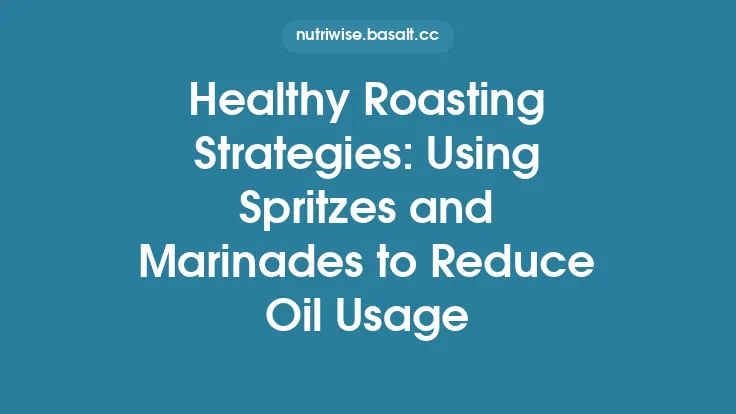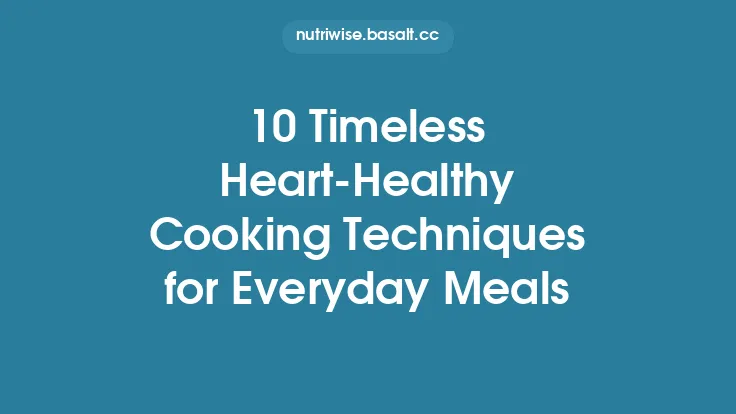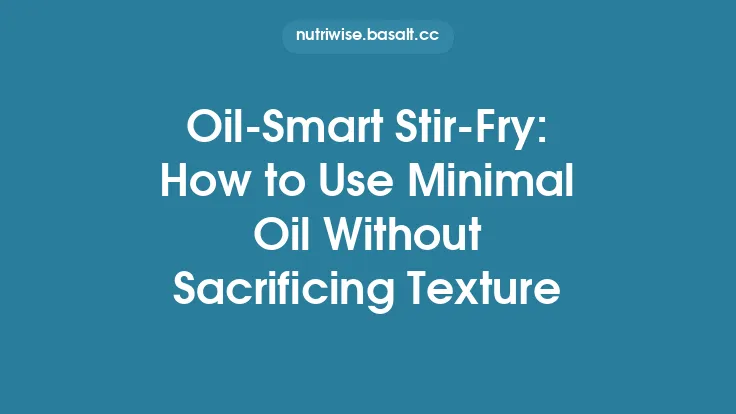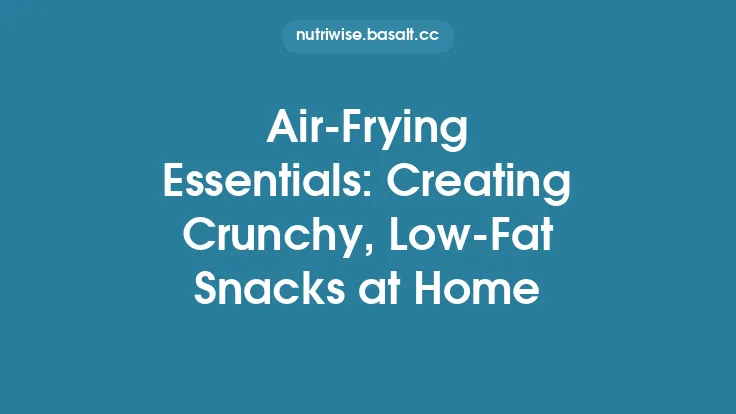Grilling is often celebrated for its ability to impart smoky flavor and a satisfying char to foods, but many home cooks assume that achieving a truly crispy exterior requires a generous coating of oil. In reality, with the right techniques, equipment, and a bit of scientific know‑how, you can produce crisp, golden‑brown results while keeping added fat to a minimum. This guide walks you through the fundamentals of low‑fat grilling, from preparing the grill and selecting the proper cuts of protein or vegetables, to mastering temperature zones and finishing touches that lock in texture without drowning your dish in oil.
Understanding the Science Behind Crispy Grilling
Crispness on the grill is primarily the result of two chemical processes: the Maillard reaction and caramelization. Both require heat, low moisture, and, in many cases, a small amount of surface fat to conduct the reaction efficiently.
- Maillard Reaction – Occurs when amino acids and reducing sugars react at temperatures above roughly 285 °F (140 °C). This creates the complex, savory flavors and the brown crust we associate with grilled foods.
- Caramelization – The breakdown of sugars at higher temperatures (around 320 °F/160 °C and above) contributes additional sweetness and a deeper color.
When you reduce added oil, you must compensate by ensuring the food’s surface is as dry as possible and that the grill’s temperature is high enough to drive these reactions quickly. Moisture acts as a heat sink, lowering the surface temperature and preventing the crust from forming. Therefore, patting proteins and vegetables dry, using salt to draw out excess water, and employing high, direct heat are essential steps.
Choosing the Right Grill and Tools
Not all grills are created equal when it comes to low‑fat, crispy results. Here’s what to look for:
| Grill Type | Low‑Fat Advantages | Key Considerations |
|---|---|---|
| Gas Grill | Precise temperature control; quick heat-up; easy to create distinct direct/indirect zones. | Ensure burners are clean to avoid flare‑ups that can add unwanted char. |
| Charcoal Grill | Natural smoke flavor; high heat potential for searing. | Requires careful arrangement of coals to manage direct vs. indirect heat. |
| Electric Grill | Consistent heat; no open flame, reducing the risk of excess fat dripping onto burners. | May not reach the same searing temperatures as gas or charcoal. |
| Stovetop Grill Pan (Cast Iron) | Ideal for indoor low‑fat grilling; retains heat well, creating a sear without added oil. | Must preheat thoroughly; use a well‑seasoned pan to prevent sticking. |
Essential Tools
- Grill Grates with Wide Slots – Allow fat to drip away while still providing a sturdy surface for searing.
- Grill Mats or Perforated Grill Sheets – Made from stainless steel or ceramic, these provide a non‑stick surface without the need for oil, while still permitting airflow.
- Heavy‑Duty Grill Press – Helps achieve even contact with the grate, promoting uniform browning.
- Thermometer (Probe or Infrared) – Accurate temperature monitoring ensures you stay within the optimal searing range.
Preparing Foods for Low‑Fat Grilling
1. Dry the Surface
After rinsing, pat proteins (chicken breast, fish fillets, lean steak) and vegetables (zucchini, bell peppers, mushrooms) with paper towels. For extra dryness, sprinkle a light layer of kosher salt and let sit for 10–15 minutes; the salt will draw out moisture, which you can then blot away.
2. Use Minimal Fat Strategically
A thin brush of oil (or a quick mist) can be applied to the grill grates rather than the food itself. This creates a lubricated surface that prevents sticking while keeping the food’s own fat content low. If you prefer to avoid oil entirely, a well‑seasoned cast‑iron grill pan or a stainless‑steel grill mat can serve the same purpose.
3. Apply Flavor Enhancers
- Dry Rubs – Combine spices, herbs, and a pinch of sugar (for caramelization) to create a flavorful crust. The sugar helps promote browning without added fat.
- Marinades with Acidic Components – Citrus juice, vinegar, or yogurt can tenderize lean proteins while adding moisture that evaporates quickly on the grill, leaving a crisp exterior.
- Umami Boosters – A sprinkle of nutritional yeast, miso paste, or a dash of low‑sodium soy sauce can enhance depth of flavor without fat.
Mastering Temperature Zones
Low‑fat grilling thrives on the strategic use of direct and indirect heat:
- Direct Heat (High Zone) – Ideal for searing the exterior. Aim for 450–550 °F (230–290 °C). Place the food directly over the flame or hot coals for 2–4 minutes per side, depending on thickness.
- Indirect Heat (Medium Zone) – Used to finish cooking without burning. Reduce the temperature to 300–350 °F (150–175 °C) and move the food away from the flame. This allows the interior to reach safe temperatures while preserving the crisp crust.
Technique Example: Chicken Breast
- Preheat the grill to a high direct‑heat zone (≈500 °F).
- Place the seasoned, dry chicken breast directly over the heat for 2 minutes per side, creating a golden sear.
- Transfer the breast to the indirect zone, close the lid, and continue cooking until the internal temperature reaches 165 °F (74 °C).
- Rest for 5 minutes; the crust will stay crisp while the juices redistribute.
Leveraging Natural Fats and Moisture
Even lean cuts contain a small amount of intramuscular fat (marbling) that can render during grilling, contributing to crispness. For ultra‑lean proteins (e.g., skinless turkey breast), consider:
- Wrapping in Foil with Aromatics – A brief “steam‑then‑sear” method: start the protein in a foil packet with herbs and a splash of broth for 5 minutes, then unwrap and finish on direct heat. The initial steam keeps the meat moist, while the final sear creates a crisp exterior without added oil.
- Using Fat‑Rich Accompaniments – A thin layer of finely diced avocado or a smear of low‑fat Greek yogurt applied after grilling adds richness without the need for cooking oil.
Achieving Crispy Vegetables
Vegetables pose a unique challenge because they contain high water content. Here’s how to overcome it:
- Slice Uniformly – Thin, even slices (¼‑inch) increase surface area and reduce cooking time.
- Pre‑Roast or Par‑Boil – Briefly blanch or microwave vegetables for 2–3 minutes, then dry thoroughly. This reduces internal moisture.
- Season with Salt and Sugar – A pinch of sugar accelerates caramelization; salt draws out residual water.
- Grill on a Perforated Sheet – The sheet prevents direct contact with the grate, allowing moisture to escape while still achieving grill marks.
Finishing Touches for Extra Crunch
- High‑Heat Broil Finish – After the main grilling phase, move the food under a broiler (or the hottest part of the grill) for 1–2 minutes. This rapid, intense heat adds a final layer of crunch.
- Sprinkle with Crispy Elements – Toasted nuts, seeds, or a dusting of toasted breadcrumbs (made from whole‑grain bread) can be added just before serving for texture without extra oil.
- Use a Light Glaze – A quick brush of reduced balsamic vinegar or a sugar‑free glaze at the end of cooking creates a glossy, crisp coating that locks in flavor.
Cleaning and Maintaining a Low‑Fat Grill
A clean grill surface is essential for preventing food from sticking and for ensuring consistent heat transfer:
- Pre‑heat and Scrape – After each grilling session, heat the grill to high and use a stainless‑steel brush to remove residue.
- Season Cast‑Iron Grates – Lightly coat with a thin film of oil and heat to polymerize; this creates a natural non‑stick surface that reduces the need for added oil.
- Remove Fat Drips Promptly – Collect and discard any fat that drips into the firebox or drip pan; excess fat can cause flare‑ups that char food unevenly.
Troubleshooting Common Issues
| Problem | Likely Cause | Solution |
|---|---|---|
| Food sticks to the grate | Grate not hot enough; surface still moist | Preheat grill for at least 10 minutes; ensure food is patted dry |
| No crisp crust, just steamed texture | Temperature too low; excess moisture | Increase direct‑heat temperature; use a grill press for better contact |
| Burnt exterior, undercooked interior | Heat too high, insufficient indirect zone | Use two‑zone setup; sear quickly then finish on indirect heat |
| Greasy drippings causing flare‑ups | Too much oil applied to food | Apply oil to grill surface instead of food; use lean cuts |
Health Benefits of Low‑Fat Grilling
Beyond the obvious reduction in added calories, low‑fat grilling preserves the nutritional integrity of foods:
- Retention of Heat‑Sensitive Nutrients – Quick, high‑heat searing minimizes the time nutrients are exposed to heat, preserving vitamins like C and B‑complex.
- Reduced Formation of Harmful Compounds – Excess fat can lead to higher levels of heterocyclic amines (HCAs) and polycyclic aromatic hydrocarbons (PAHs) when it drips onto flames. By limiting added fat, you lower the risk of these compounds forming.
- Improved Satiety – The Maillard‑induced crust provides a satisfying mouthfeel, helping you feel fuller with less overall fat.
Sample Low‑Fat Grilling Menu
| Course | Dish | Key Low‑Fat Technique |
|---|---|---|
| Starter | Grilled Portobello caps with herb dry rub | Direct high heat, grill mat, no oil |
| Main | Lemon‑herb chicken breast with foil‑steam start | Foil packet, indirect finish, minimal oil on grate |
| Side | Charred asparagus with toasted almond slivers | Pre‑blanch, dry, high‑heat sear, finish with toasted nuts |
| Dessert | Grilled pineapple rings with balsamic glaze | Quick high‑heat sear, light glaze applied at end |
Final Thoughts
Low‑fat grilling is less about eliminating oil entirely and more about mastering the interplay of heat, moisture, and surface chemistry. By drying foods, using strategic temperature zones, selecting the right equipment, and applying flavor‑boosting techniques that don’t rely on excess fat, you can achieve that coveted crispy, caramelized exterior while keeping your meals light and nutritious. The result is a flavorful, health‑conscious grilling experience that doesn’t sacrifice the satisfying crunch that makes grilled food so beloved. Happy grilling!





